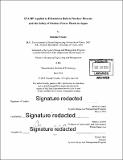| dc.contributor.advisor | Nancy Leveson. | en_US |
| dc.contributor.author | Uesako, Daisuke | en_US |
| dc.contributor.other | Massachusetts Institute of Technology. Engineering Systems Division. | en_US |
| dc.coverage.spatial | a-ja--- | en_US |
| dc.date.accessioned | 2017-03-20T19:41:47Z | |
| dc.date.available | 2017-03-20T19:41:47Z | |
| dc.date.copyright | 2016 | en_US |
| dc.date.issued | 2016 | en_US |
| dc.identifier.uri | http://hdl.handle.net/1721.1/107596 | |
| dc.description | Thesis: S.M. in Engineering and Management, Massachusetts Institute of Technology, School of Engineering, System Design and Management Program, Engineering and Management Program, 2016. | en_US |
| dc.description | Cataloged from PDF version of thesis. | en_US |
| dc.description | Includes bibliographical references. | en_US |
| dc.description.abstract | On March 11, 2011, a huge tsunami generated after the Great East Japan Earthquake triggered an extremely severe nuclear accident at the Fukushima Daiichi Nuclear Power Plant. This thesis analyzes why the stakeholders could not prevent the Fukushima Daiichi nuclear disaster, and, with regard to the future nuclear safety in Japan, what the potentially hazardous control actions could be. Because of the complex sociotechnical nature of nuclear power plants, System-Theoretic Accident Model and Processes (STAMP)-specifically, Causal Analysis based on STAMP (CAST) and System-Theoretic Process Analysis (STPA)-is used for these analyses. The CAST process reveals the whole picture of the unsafe control actions by multiple stakeholders, as well as their flawed communication and coordination, which significantly damped the overall control structure for the Fukushima Daiichi Nuclear Power Plant. It becomes clear that all the stakeholders were inadequate to fulfill their safety requirements regarding the safety design, safety management and emergency response. The shared notion of the "Safety Myth," which emerged as an "explanation on safety" for the purpose of promoting the use of nuclear power and was enhanced, among others, by administrative issues such as lack of leadership on nuclear safety, flawed safety culture, lack of resources at the regulatory bodies and bureaucracy, restricted the efforts by the stakeholders to ensure the actual safety against severe accidents or compound nuclear disasters. The STPA process identifies a number of unsafe control actions in the control structure for the safety of nuclear power plants in Japan, the causal scenarios by which these unsafe control actions could occur, and possible safety requirements to prevent these causal scenarios. It is demonstrated that, despite extensive improvements by the stakeholders after the Fukushima Daiichi nuclear disaster including the establishment of a new regulatory body, the "Safety Myth" or administrative issues might still come into play as causal factors, while investment for safety and sound safety culture can be possible safety requirements that subdue these causal factors. Finally, recommendations to strengthen the current safety control structure are developed for some key stakeholders, based on the findings of these analyses. | en_US |
| dc.description.statementofresponsibility | by Daisuke Uesako. | en_US |
| dc.format.extent | 122 pages | en_US |
| dc.language.iso | eng | en_US |
| dc.publisher | Massachusetts Institute of Technology | en_US |
| dc.rights | MIT theses are protected by copyright. They may be viewed, downloaded, or printed from this source but further reproduction or distribution in any format is prohibited without written permission. | en_US |
| dc.rights.uri | http://dspace.mit.edu/handle/1721.1/7582 | en_US |
| dc.subject | Engineering and Management Program. | en_US |
| dc.subject | System Design and Management Program. | en_US |
| dc.subject | Engineering Systems Division. | en_US |
| dc.title | STAMP applied to Fukushima Daiichi nuclear disaster and the safety of nuclear power plants in Japan | en_US |
| dc.title.alternative | System-Theoretic Accident Model and Processes applied to Fukushima Daiichi nuclear disaster and the safety of nuclear power plants in Japan | en_US |
| dc.type | Thesis | en_US |
| dc.description.degree | S.M. in Engineering and Management | en_US |
| dc.contributor.department | Massachusetts Institute of Technology. Engineering and Management Program | en_US |
| dc.contributor.department | System Design and Management Program. | en_US |
| dc.identifier.oclc | 974712182 | en_US |
